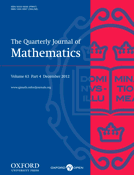
QUARTERLY JOURNAL OF MATHEMATICS
Scope & Guideline
Illuminating the Path of Mathematical Discovery
Introduction
Aims and Scopes
- Algebraic Geometry and Number Theory:
The journal features research on algebraic structures, moduli spaces, and the interplay between geometry and number theory, including topics like elliptic curves and L-functions. - Topology and Geometric Analysis:
Papers often explore topological properties of manifolds, homotopy theory, and geometric structures, contributing to the understanding of complex topological phenomena. - Functional Analysis and Operator Theory:
Research in this area includes the study of Banach spaces, operator algebras, and functional spaces, focusing on their applications in various mathematical contexts. - Combinatorial and Additive Number Theory:
The journal publishes work related to combinatorial structures, additive number theory, and their implications in broader mathematical theories. - Mathematical Physics and Geometry:
Research at the intersection of mathematics and physics is prevalent, with topics such as instantons, gauge theory, and quantum geometry being explored. - Mathematical Methods in Analysis:
The journal emphasizes analytical techniques and their applications, including variational methods, PDEs, and advanced calculus.
Trending and Emerging
- Higher-Dimensional Algebra and Topological Invariants:
There is a noticeable increase in research focused on higher-dimensional algebraic structures and their topological invariants, reflecting a growing interest in understanding complex relationships within algebraic topology. - Non-commutative Geometry and Operator Algebras:
Emerging themes in non-commutative geometry and the study of operator algebras are prevalent, indicating a trend towards exploring new mathematical frameworks that challenge traditional geometric perspectives. - Arithmetic Geometry and Moduli Problems:
The journal has seen a rise in papers addressing arithmetic geometry, particularly those dealing with moduli spaces, suggesting a renewed interest in the interplay between algebraic structures and arithmetic properties. - Mathematical Aspects of Theoretical Physics:
Works connecting mathematical theories with concepts in theoretical physics, such as quantum field theory and string theory, are increasingly featured, highlighting the interdisciplinary nature of contemporary mathematical research. - Advanced Techniques in Spectral Theory and PDEs:
Recent publications indicate a trend towards sophisticated techniques in spectral theory, particularly in relation to partial differential equations, reflecting the importance of these methods in modern mathematical analysis.
Declining or Waning
- Elementary Number Theory:
Topics related to basic number theory, such as elementary divisibility and congruences, appear to be less frequent, possibly overshadowed by more complex and abstract developments in algebraic number theory. - Classical Geometry:
Research focusing solely on classical geometric constructs, such as Euclidean or non-Euclidean geometry, seems to be waning, as more emphasis is placed on algebraic and topological approaches. - Basic Combinatorial Structures:
While combinatorial mathematics remains relevant, works focusing on elementary combinatorial techniques are less common, as the field shifts towards more sophisticated combinatorial designs and applications. - Applications of Classical Analysis:
Papers that strictly apply classical analysis methods to solve problems in isolation are becoming rarer, with a trend towards integrating these methods with other modern approaches. - Discrete Mathematics:
Although still important, traditional discrete mathematics topics are appearing less frequently, as the journal's focus evolves towards more complex interactions within discrete structures.
Similar Journals
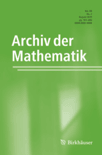
ARCHIV DER MATHEMATIK
Advancing Mathematical Frontiers Since 1948ARCHIV DER MATHEMATIK is a distinguished journal published by SPRINGER BASEL AG, renowned for its contributions to the field of mathematics. Established in 1948 and continuing its legacy through to 2024, the journal provides a platform for innovative research and scholarly articles that push the boundaries of mathematical theory and application. With an ISSN of 0003-889X and an E-ISSN of 1420-8938, it holds a reputable position within the academic community, reflected by its Q2 ranking in the 2023 Mathematics (Miscellaneous) category. Despite not being an open access publication, ARCHIV DER MATHEMATIK remains accessible to a global audience through various databases, ensuring the dissemination of high-quality research. The journal’s commitment to enhancing mathematical discourse makes it an essential resource for researchers, professionals, and students seeking to expand their understanding of this vital discipline.

Cambridge Journal of Mathematics
Advancing Mathematical Frontiers with Every IssueCambridge Journal of Mathematics, published by INT PRESS BOSTON, INC, is a premier platform for the dissemination of cutting-edge research in the field of mathematics. With an ISSN of 2168-0930 and E-ISSN 2168-0949, this journal stands out in a competitive academic landscape, currently ranked #58 out of 399 in General Mathematics, placing it in the top 15% within its category according to Scopus metrics. The journal serves as a vital resource for researchers, professionals, and students alike, aiming to foster groundbreaking mathematical inquiries and foster collaboration across disciplines. Published from 2020 to 2024, the Cambridge Journal of Mathematics is committed to maintaining high standards of scholarship, making it an essential read for those who are passionate about advancing mathematical knowledge and its applications.
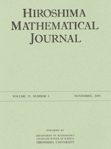
Hiroshima Mathematical Journal
Connecting Researchers Through Innovative Mathematical InsightsThe Hiroshima Mathematical Journal, published by Hiroshima University, Graduate School of Science, serves as a prominent platform for disseminating high-quality research in the field of mathematics. Established in 1959, the journal has been an integral part of the mathematical community, focusing on areas such as Algebra, Number Theory, Analysis, and Geometry and Topology. Although currently classified in Q4 quartile rankings within its categories, the journal is committed to advancing mathematical knowledge and fostering scholarly dialogue. Its accessibility, combined with its long-standing history, makes it an essential resource for researchers, professionals, and students dedicated to exploring and enhancing the mathematical sciences. For those interested in contributing or accessing cutting-edge research, the Hiroshima Mathematical Journal continues to uphold its mission of excellence in mathematical scholarship.

Selecta Mathematica-New Series
Fostering Collaboration Among Leading Minds.Selecta Mathematica-New Series is a premier academic journal published by Springer International Publishing AG, based in Switzerland. With an impressive impact in the fields of Mathematics and Physics, it is recognized in the Q1 category for both Mathematics (Miscellaneous) and Physics and Astronomy (Miscellaneous) as of 2023. Established in 1995, the journal provides a platform for rigorous peer-reviewed research, facilitating the dissemination of groundbreaking findings and theoretical advancements through its converged publication years up to 2024. Researchers and scholars seeking to stay at the forefront of mathematical and physical sciences will benefit from the journal's diverse scope and high-impact articles. Although it does not operate under an open-access model, Selecta Mathematica-New Series remains a vital resource for building knowledge and fostering collaboration among professionals and students engaged in these dynamic fields. Access to its content is essential for those aiming to deepen their understanding and contribute to the ongoing dialogue within the scientific community.

JOURNAL OF DIFFERENTIAL GEOMETRY
Pioneering insights in geometry, algebra, and analysis.JOURNAL OF DIFFERENTIAL GEOMETRY, a premier publication by INT PRESS BOSTON, INC, has established itself as a leading forum for the dissemination of high-quality research in the fields of differential geometry, algebra, and analysis. With an impressive history that spans from 1967 to 2024, this journal is recognized for its rigorous peer-reviewed articles, contributing significantly to the advancement of mathematical theories and innovative approaches. Notably, the journal boasts a Q1 ranking in key categories such as Algebra and Number Theory, Geometry and Topology, and Analysis, reflecting its pivotal role within the mathematics community. Its Scopus rankings reinforce its reputation, placing it among the top-tier journals in its respective fields, with a 97th percentile ranking in Algebra and Number Theory, further emphasizing its influence. While the journal does not offer Open Access options, it remains a critical resource for researchers, professionals, and students aiming to stay at the forefront of developments in differential geometry and related domains. Engage with groundbreaking research and explore new methodologies that are shaping the future of mathematics.

HOUSTON JOURNAL OF MATHEMATICS
Unveiling New Perspectives in Mathematical DisciplinesHOUSTON JOURNAL OF MATHEMATICS, published by the University of Houston, serves as a valuable platform for disseminating significant findings in the field of mathematics, specifically within the realm of miscellaneous mathematics. Despite its current categorization in Q4 for 2023, the journal plays a crucial role in fostering academic discussion and exploration among researchers, professionals, and students alike. With its ISSN 0362-1588, the journal has been publishing original research since 1996, with a recent gap filled from 2022 to 2023, thereby continuing to contribute to the mathematical community. While it does not currently offer open access options, the journal's commitment to quality research maintains its relevance within the field and invites submissions that can elevate its standing. Located in the vibrant city of Houston, Texas, the journal not only emphasizes theoretical advancements but also encourages applied mathematical research that intersects with other disciplines, enhancing its significance and reach.
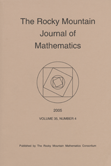
ROCKY MOUNTAIN JOURNAL OF MATHEMATICS
Fostering Collaboration in Diverse Mathematical FieldsROCKY MOUNTAIN JOURNAL OF MATHEMATICS, published by the Rocky Mountain Math Consortium, serves as a critical platform for researchers and practitioners in the field of mathematics since its inception in 1971. With a notable presence in the academic community, this journal covers a broad spectrum of mathematical disciplines, positioning itself in the Q2 category for Mathematics (miscellaneous) as of 2023. Despite being a subscription-based journal, it is recognized for its rigorous peer-review process and contributions to theoretical and applied mathematics, helping to advance knowledge and foster collaboration among mathematicians. The journal's ISSN number is 0035-7596 and its E-ISSN is 1945-3795, reflecting its commitment to accessibility and dissemination of high-quality research. Based in Tempe, Arizona, at Arizona State University, the journal continues to play an important role in shaping contemporary mathematical discourse through well-researched articles and innovative studies, aiming to bridge gaps between various mathematical subfields and engage a diverse audience, including students and established researchers alike.
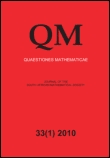
Quaestiones Mathematicae
Elevating Mathematical Research to New HeightsQuaestiones Mathematicae is a distinguished academic journal dedicated to the field of mathematics, published by Taylor & Francis Ltd, a renowned name in scholarly publishing. Established in 1976, this journal has been a critical resource for researchers, professionals, and students alike, providing a platform for innovative and rigorous advancements in miscellaneous mathematics. The journal holds a 2023 Scopus rank of 35 out of 90 in its category, reflecting its significant contribution to the field with a 61st percentile standing, and whilst it is categorized in the Q3 quartile, it remains an essential avenue for sharing pivotal mathematical research. Although not open access, Quaestiones Mathematicae offers a rich archive of acclaimed papers, encouraging scholarly dialogue and fostering the growth of mathematical knowledge. With a converged span extending to 2024, it continues to evolve and adapt, ensuring its relevance and impact within the global academic community.

ANNALES DE L INSTITUT FOURIER
Elevating Mathematical Discourse GloballyANNALES DE L INSTITUT FOURIER is a premier academic journal published by ANNALES INST FOURIER, specializing in the fields of Algebra and Number Theory as well as Geometry and Topology. Since its establishment, the journal has garnered a distinguished reputation, evidenced by its Q1 quartile ranking in the 2023 category assessments and its Scopus Rank of #37 out of 119 in Algebra and Number Theory, and #34 out of 106 in Geometry and Topology, placing it within the top percentile of its field. The journal serves as a vital platform for disseminating groundbreaking research and innovative methodologies, catering to a global audience of researchers, professionals, and students. With a commitment to the advancement of mathematical sciences, ANNALES DE L INSTITUT FOURIER invites contributions that push the boundaries of knowledge and foster collaboration across disciplines. Although it does not offer open access, the rigorous peer-review process ensures that published papers meet the highest academic standards, making it a critical resource for anyone engaged in advanced mathematical research.
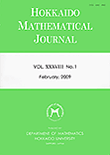
Hokkaido Mathematical Journal
Fostering scholarly dialogue in the world of mathematics.Hokkaido Mathematical Journal, published by Hokkaido University, Department of Mathematics, stands as a pivotal platform for scholarly discourse in the field of mathematics. Established in 1972, this peer-reviewed journal has consistently contributed to the advancement of mathematical research, covering a wide spectrum of topics within the discipline. With its current ranking in the third quartile (Q3) among miscellaneous mathematics journals, it offers valuable insights and findings that cater to both established researchers and budding mathematicians alike. The journal is accessible through traditional subscription, fostering a community that values rigorous theoretical exploration and applied mathematical methods. As it approaches its convergence year in 2024, Hokkaido Mathematical Journal remains essential for those dedicated to pushing the boundaries of mathematical knowledge and innovation in Japan and beyond.